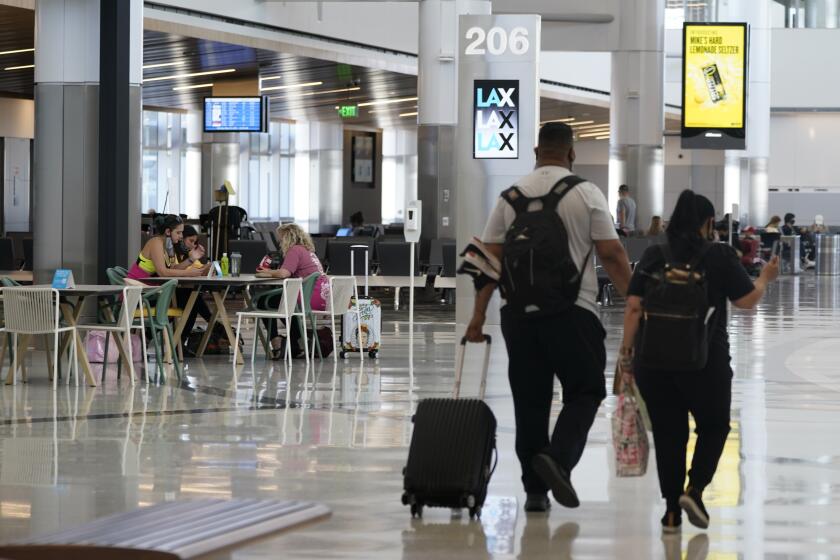Cost to Homes, Wildlife Weighed in Railway Plan : Transportation: Antelope Valley officials seek to have high-speed train route run through area, though the project could displace residents and endanger species.
- Share via
A proposed high-speed rail system running through the Antelope Valley and connecting Los Angeles with Northern California could displace more than 260 homes and businesses, as well as endanger several rare plant and animal species, according to a preliminary study released by Caltrans.
But local officials say they are willing to pay that price for the benefit of having the Antelope Valley included in the route of a 21st-Century rail line that could eventually connect Los Angeles with San Francisco and Sacramento.
The proposed railway would be capable of speeds up to 310 m.p.h., making the trip from Los Angeles to Sacramento in two hours. But state Department of Transportation officials must decide between a route through the Antelope Valley or one along Interstate 5 through Gorman.
“We absolutely want the alignment to run through here,” said Jeff Long, Lancaster’s director of public works. “When it is built, it will run through the Antelope Valley with a population that will grow to over a million people. It would be strange to bypass us.
“This type of transportation plan is vital to the economy of the area, Long added. “In the end, there will be a few displaced homes on any of the routes that you take.”
*
A public workshop hosted by Caltrans officials will be held today and Tuesday in the Santa Clarita and Antelope valleys for residents to voice their opinions about the two possible routes connecting a portion of proposed rail between Los Angeles and Bakersfield.
Some of the debate is expected to focus on the environmental effects of the rail project.
“When you travel these distances, you are going to run into these important ecological areas,” said Dave Mansen, senior project manager with Myra, Frank & Associates in Los Angeles, the firm that performed the preliminary environmental study for Caltrans.
The railway, which could begin construction as early as the year 2000, could run through Los Angeles, Glendale, Burbank, San Fernando, Santa Clarita, Palmdale, Lancaster, Tehachapi and Bakersfield, officials said.
Caltrans is still seeking funds for the system, expected to cost between $5 billion and $9 billion.
Both routes follow the Southern Pacific/Metrolink railroads from Union Station in Los Angeles to Santa Clarita. At that point the route splits into two possible lines. One closely follows Interstate 5 and then travels along either Edison Road or Union Avenue to Bakersfield.
The alternative is to follow the Antelope Valley Freeway into the Antelope Valley and then along California 58 to Bakersfield.
The study calls for 15 houses to be relocated between Los Angeles and Sylmar, including five single-family homes north of Union Station, 10 homes near the Burbank Airport on Sancola Avenue and Ferncola Avenue and some commercial property in the area, Mansen said.
In the Antelope Valley, as many as 150 homes could be displaced. Most are located in Soledad Canyon; 62 of the residences are in a single mobile home park, the study said.
In the southern end of Palmdale, 15 homes would have to be acquired east of the Antelope Valley Freeway, Mansen said.
In addition, seven species of wildlife will be affected, including the blunt-nose leopard lizard, the San Joaquin kit fox and the Tipton kangaroo rat, all of which are protected under federal and state endangered- or threatened-species laws.
*
Two plants that could be severely affected by each of the proposed rail routes are the Bakersfield atriplex and the slender-horned spineflower in the Antelope Valley. Both are protected by federal and state laws.
The first public workshop on the two routes will be held at the Valencia Towne Center in the Community Room today from 5 to 8 p.m. On Tuesday, a workshop will be held in the Stanley Kleiner Center at Lancaster City Park from 4 to 7 p.m.
Copies of the High Speed Ground Transportation Feasibility Study, released last week, are available at the Newhall, Palmdale, Lancaster and Burbank public libraries through Sept. 30.
Caltrans will also accept written comments until that date.
More to Read
Sign up for Essential California
The most important California stories and recommendations in your inbox every morning.
You may occasionally receive promotional content from the Los Angeles Times.










